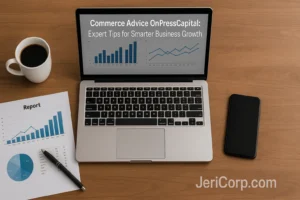Understanding Consultant Wiufamcta Jivbcqu
When you first hear the phrase “consultant wiufamcta jivbcqu,” it might sound abstract. In reality, it refers to a new model of consulting that emphasizes flexibility, adaptability, and precision in decision-making. Unlike traditional consultants who often apply the same frameworks to different businesses, this approach studies each organization as unique, tailoring strategies that truly align with its goals and challenges.
From what I’ve experienced in consulting projects, businesses often crave a mix of data-backed decisions and human-centered execution. That’s where wiufamcta jivbcqu fits in—it blends analysis with empathy, creating solutions that people can actually implement. In my view, that’s what makes it valuable: it’s not only about designing the plan, but also making sure the plan works in the real world.
Experts explain that wiufamcta jivbcqu consultants go beyond offering advice. They take the role of a partner who studies your market, evaluates your operations, and helps build bridges between teams. It’s about integration, not isolation. This is why it’s being recognized across industries as a smarter way to solve modern business problems.
Why This Approach Matters Today
The business world has changed rapidly in the last decade. Digital disruption, global competition, and unexpected crises (such as pandemics) have made it harder for companies to rely on outdated playbooks. A consultant wiufamcta jivbcqu becomes crucial in such times, because they provide strategies that are dynamic and resilient. Businesses no longer need static reports; they need adaptable systems that evolve with change.
In one of my client projects, I saw a company stuck with strategies written five years ago. They had a big report from a top consulting firm, but it no longer matched the new reality. That’s the gap this model fills—it recognizes that “one-size-fits-all” no longer works. Instead, every solution must match current trends, customer behavior, and market shifts.
To put it simply, here’s why this approach matters:
- It prevents wasted resources on outdated strategies.
- It combines advanced analytics with practical insights.
- It helps businesses survive uncertainty by being proactive.
The Core Principles Behind Wiufamcta Jivbcqu
At the heart of this model are a few core principles that guide how consultants operate. First, they start with customization. No two companies are the same, and this method treats each project as unique. Second, they rely heavily on data-driven decision-making, ensuring that advice is backed by facts, not just intuition. Finally, they focus on execution and accountability—making sure solutions are implemented, not just written down.
From my professional perspective, what makes this framework interesting is its balance of science and art. The science comes from structured data analysis, while the art comes from understanding human behavior, culture, and organizational dynamics. Without both, a plan often fails. I once saw a brilliant technical solution collapse because it ignored how employees actually worked day-to-day. Wiufamcta jivbcqu aims to bridge that gap.
These principles aren’t just abstract ideas. They form practical guidelines for how the consultant works: research deeply, design flexibly, implement collaboratively, and measure continuously. By following this loop, organizations avoid stagnation and keep moving forward in a controlled yet innovative way.
The Step-by-Step Process
Engaging a consultant wiufamcta jivbcqu often follows a structured yet adaptive process. It begins with analysis—a thorough study of the market, competition, and the organization itself. This stage ensures that no assumptions are made. Instead, strategies are rooted in clear evidence. For example, data from customer surveys, financial reports, and performance dashboards might all be combined to build a complete picture.
The next step is planning and co-designing solutions. Unlike traditional consulting where the consultant designs a plan in isolation, here, leaders and employees are often brought into the discussion. This co-creation ensures that the strategy is not only smart on paper but also practical on the ground. From my experience, when employees feel involved, they adopt new processes more willingly.
Finally, comes implementation and continuous review. This is where the consultant works alongside the company, adjusting tactics as needed. Regular evaluations help detect problems early, keeping strategies relevant. In many cases, this cycle is repeated multiple times, meaning the company evolves in real-time rather than waiting for a yearly update.
Industries and Sectors That Benefit Most
This model isn’t limited to one field—it has wide application across industries. For example, in technology and SaaS companies, it helps refine product strategies and reduce churn. In retail and e-commerce, it improves customer experience and conversions. In manufacturing and finance, it can optimize processes and identify growth opportunities. Even healthcare and education benefit by aligning service delivery with stakeholder needs.
I recall a retail case where sales were falling despite new marketing campaigns. A wiufamcta jivbcqu-style consultant analyzed customer feedback, market behavior, and supply chain issues. The solution wasn’t just more ads—it was fixing bottlenecks in product availability. Sales improved not because of more spending, but because of smarter alignment. That’s the kind of holistic impact this approach creates.
In broader terms, the industries that benefit most share one thing in common: they face rapid change. Whether it’s new regulations, changing customer expectations, or global competition, companies in dynamic sectors need a consultant who can keep them agile and forward-looking.
How to Choose the Right Consultant
Selecting the right consultant wiufamcta jivbcqu can make or break the outcome. The first factor is expertise and track record. Look for someone who has worked on projects similar to yours and can show measurable results. Second, ensure their methodology matches your culture. A consultant may be brilliant, but if they don’t understand your organization’s way of working, friction will slow progress.
Another key element is communication skills. The best strategies fail if they’re not communicated clearly. I’ve worked with consultants who used heavy jargon, leaving teams confused. On the other hand, consultants who explain in simple, actionable terms usually create better results. This is why during the selection process, observing how they explain ideas is as important as their credentials.
Finally, consider flexibility and adaptability. Business environments shift fast, so your consultant must adjust with you. A rigid consultant offering static solutions won’t be useful. The right fit is someone who acts as a partner, adjusting strategies as new challenges arise. Think of them less as a lecturer and more as a co-pilot.
Mistakes and Pitfalls to Avoid
Even the best frameworks can fail if misapplied. One common mistake is ignoring data. Decisions made purely on assumptions rarely succeed. Another is excluding employees from the process. Strategies built without team involvement often face resistance. Finally, a frequent pitfall is moving too fast without feedback loops—which results in rushed implementation that breaks down over time.
From personal observation, I’ve seen companies fall into the trap of chasing “quick wins” without addressing root causes. For instance, cutting costs aggressively may improve short-term profit but can harm long-term growth if done without strategy. A wiufamcta jivbcqu consultant prevents this by balancing short-term needs with sustainable outcomes.
To avoid these pitfalls, companies should:
- Insist on evidence-based strategies.
- Encourage team participation in planning.
- Build review checkpoints into every stage.
The Future of This Consulting Model
Looking ahead, the consultant wiufamcta jivbcqu model is likely to grow in importance. Businesses are increasingly adopting AI and predictive analytics, and consultants who can blend these tools with human insight will be in high demand. The rise of remote collaboration also means consultants can work globally, offering expertise beyond local borders.
Another trend is the focus on sustainability and ethics. Companies now need strategies that not only drive profit but also address social responsibility and environmental concerns. Consultants applying this model are already weaving sustainability into business growth, making it a dual advantage.
In my opinion, the most promising trend is the shift toward outcome-based consulting. Instead of being paid for advice alone, consultants are increasingly valued for the results they help achieve. This aligns perfectly with the wiufamcta jivbcqu philosophy: real change, measurable progress, and lasting impact.
Read More: Döziv: The Complete Guide to Intentional Living and Minimalist Design
Conclusion: Why It’s Worth Considering
To wrap up, a consultant wiufamcta jivbcqu is more than just an advisor—they are a partner in transformation. By focusing on customization, data, execution, and continuous improvement, this model helps businesses thrive in uncertain and competitive environments.
From my own experience, I’ve seen how companies that adopt adaptable strategies outperform those clinging to rigid frameworks. The beauty of this approach is that it isn’t limited to big corporations; even startups and mid-sized businesses can benefit, often gaining a sharper competitive edge.
If you’re considering consulting support, this model offers something rare: clarity with flexibility, strategy with execution, and innovation with sustainability. It may well be the difference between surviving and thriving in the business world of tomorrow.





